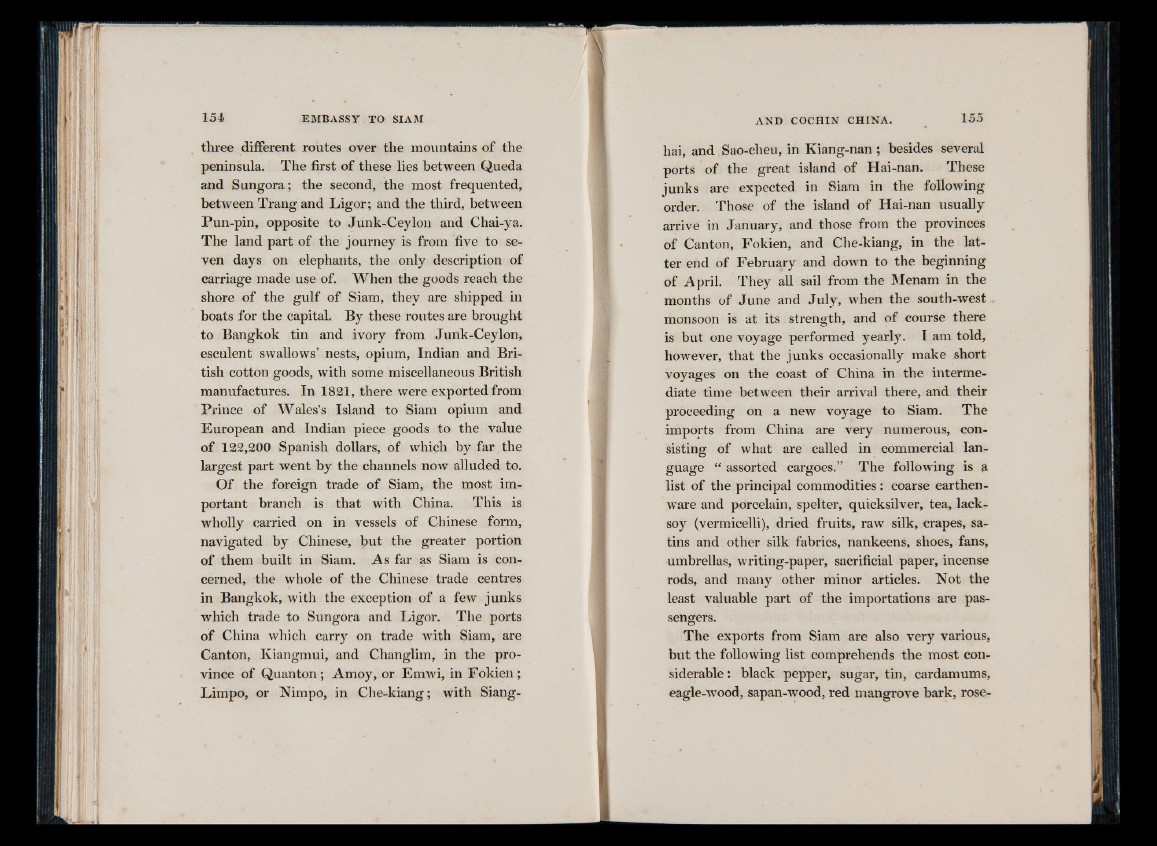
three different routes over the mountains of the
peninsula. The first of these lies between Queda
and Sangora; the second, the most frequented,
between Trangand Ligor; and the third, between
Pun-pin, opposite to Junk-Ceylon and Chai-ya.
The land part of the journey is from five to seven
days on elephants, the only description of
carriage made use of. When the goods reach the
shore of the gulf of Siam, they are shipped in
boats for the capital. By these routes are brought
to Bangkok tin and ivory from Junk-Ceylon,
esculent swallows’ nests, opium, Indian and British
cotton goods, with some miscellaneous British
manufactures. In 1821, there were exported from
Prince of Wales’s Island to Siam opium and
European and Indian piece goods to the value
of 122,200 Spanish dollars, of which by far the
largest part went by the channels now alluded to.
Of the foreign trade of Siam, the most important
branch is that with China. This is
wholly carried on in vessels of Chinese form,
navigated by Chinese, but the greater portion
of them built in Siam. As far as Siam is concerned,
the whole of the Chinese trade centres
in Bangkok, with the exception of a few junks
which trade to Sungora and Ligor. The ports
of China which carry on trade with Siam, are
Canton, Kiangmui, and Changlim, in the province
of Quanton; Amoy, or Emwi, in Fokien ;
Limpo, or Nimpo, in Che-kiang; with Sianghai,
and Sao-cheu, in Kiang-nan ; besides several
ports of the great island of Hai-nan. These
junks are expected in Siam in the following
order. Those of the island of Hai-nan usually
arrive in January, and those from the provinces
of Canton, Fokien, and Che-kiang, in the latter
end of February and down to the beginning
of April. They all sail from the Menam in the
months of June and July, when the south-west
monsoon is at its strength, and of course there
is but one voyage performed yearly. I am told,
however, that the junks occasionally make short
voyages on the coast of China in the intermediate
time between their arrival there, and their
proceeding on a new voyage to Siam. The
imports from China are very numerous, consisting
of what are called in commercial language
“ assorted cargoes.” The following is a
list of the principal commodities: coarse earthenware
and porcelain, spelter, quicksilver, tea, lack-
soy (vermicelli), dried fruits, raw silk, crapes, satins
and other silk fabrics, nankeens, shoes, fans,
umbrellas, writing-paper, sacrificial paper, incense
rods, and many other minor articles. Not the
least valuable part of the importations are passengers.
The exports from Siam are also very various,
but the following list comprehends the most considerable
: black pepper, sugar, tin, cardamums,
eagle-wood, sapan-wood, red mangrove bark, rose